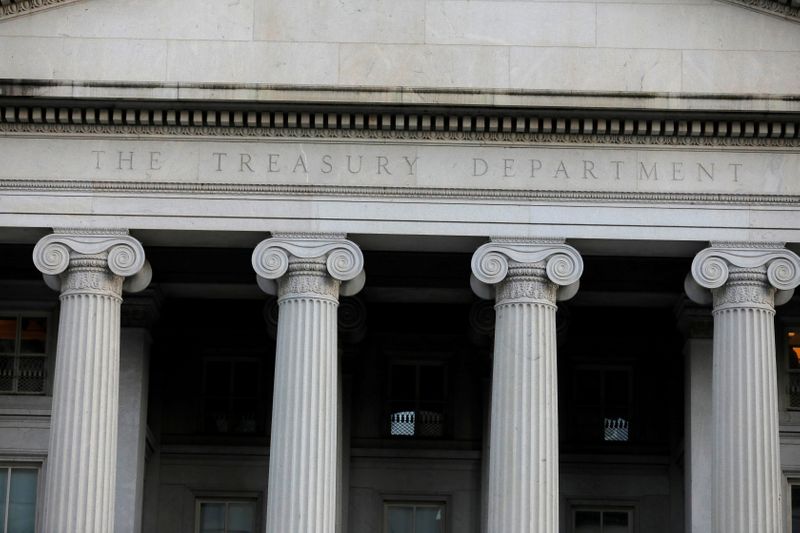By Kate Duguid
NEW YORK (Reuters) - U.S. Treasury bond yields have been shaken out of hibernation and are back above 1% after hitting record lows last year, on hopes of an economic rebound in the United States.
Though they remain historically low, a rapid rise in yields can ripple out throughout other assets, affecting everything from tech stocks to the housing market.
Why are yields rising?
The Federal Reserve cut interest rates to near-zero levels in March to spur borrowing and kick the economy out of a pandemic-fueled recession. Yields across maturities hit record lows.
But in recent months, breakthroughs in the development of COVID-19 vaccines and expectations of more fiscal stimulus under a Democrat-led Congress have pushed some investors out of Treasuries and into comparatively riskier assets such as stocks. That lifted yields to their recent highs.
The yield on the benchmark 10-year Treasury note was recently at 1.097%, after hitting a record low of 0.318% in 2020. By comparison, it stood at 1.769% approximately a year ago.
Real yields, which account for inflation, are edging higher as well, though they still remain in negative territory. Those rising inflation expectations signal investor confidence in the economy.
Where do investors think yields will go next?
Investors generally believe yields will continue their upward move in 2021, though many think the Fed - which sees rapid jumps in yields as a threat to the recovery - would likely cap a rally that moves too quickly or shoots too high.
A Reuters poll of 60 analysts in December showed a median forecast of 1.2% for the 10-year Treasury yield over the next year.
Some investors are worried about the possibility of a "taper tantrum," in which yields rise sharply when the Fed begins winding down its stimulus earlier than expected. In addition to lifting yields higher, worries over an earlier-than-expected stimulus unwind in 2013 hit investor appetite https://www.reuters.com/article/us-usa-fed-2013-timeline/key-events-for-the-fed-in-2013-the-year-of-the-taper-tantrum-idUSKCN1P52A8 for corporate bonds and caused a sharp sell-off in stocks.
The central bank has gone out of its way to assure markets that no such shift is on the near-term horizon. Janet Yellen, President Joe Biden's nominee for Treasury secretary, urged lawmakers on Tuesday to "act big" on the next coronavirus relief package, adding that the benefits outweigh the costs of a higher debt burden.
What does the rise in yields mean for other assets?
Higher Treasury yields this year have sent the dollar up approximately 0.56% against the euro - higher yields make the currency more attractive to income-seeking investors. The dollar index, which weighs the currency against a basket of six rivals, was last trading 0.25% higher for the year.
"While the dollar is still expensive on an absolute basis relative to other currencies, the steepening in the U.S. yield curve... makes the dollar start to look a little bit more attractive," said Erin Browne, portfolio manager at PIMCO.
The U.S. 10-year note now has a 160 basis point yield advantage over its German counterpart, which is trading in negative territory, up from around 100 basis points in July.
The spot price for gold, which struggles to compete with income-producing assets when yields rise, is down 1.71% this year after outperforming nearly all other assets with last year's gain of a little more than 22%.
While the stock market soared as bond yields hit historic lows last year, equities can conversely suffer https://www.reuters.com/article/us-usa-stocks-yields/rising-u-s-bond-yields-bring-back-wall-streets-sinking-feeling-idUSKCN1MK2IK from higher yields, as bonds start to offer more competition to yield-seeking investors.
Rising yields have in recent weeks been a mixed bag for stocks. Shares of financial companies, which benefit from higher rates, are up 3.72% this year, using the S&P U.S. Financials index, outpacing the S&P 500 index, which is up 2.55% over the same period.
As the economy begins to return to normal, companies whose fortunes rise and fall with the market cycle benefit. Growth stocks, which are less attuned to market moves, like tech, become less valuable. The S&P 500 technology sector is underperforming the broader index, up 2.08% this year.
How could higher Treasury yields affect individuals?
The effects of higher yields beyond Corporate America can most directly be seen in the housing market. The interest rates charged on fixed-rate mortgages tend to shadow moves in Treasury yields and have already begun edging higher.
The average rate on a 30-year mortgage, using data from the Mortgage Bankers' Association, has ticked higher in the past two weeks, though it remains just 6 basis points off its record low. A Freddie Mac (OTC:FMCC) survey has also risen this year, by 12 basis points to 2.77%.
We have seen "on average about a 10 basis point increase on the most competitive rates," said Greg McBride, chief financial analyst at Bankrate.com. "The jump in the 10-year has increased the yields that investors are requiring to purchase mortgage-backed securities."
